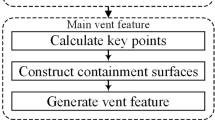Abstract
With the widespread application of mold CAD technology, it is a necessary design link for designers of mold enterprises to use three-dimensional software for mold parting design. Parting design is the most complex and key part of the whole injection mold design process. It is directly related to the success or failure of the whole mold design. In view of many problems existing in the current parting design system, such as frequent human–computer interaction, cumbersome operation, low efficiency, and heavy dependence on the experience and knowledge of designers and their software operation level, an automatic parting design algorithm based on the solid method is proposed and implemented in the developed mold automatic parting system (Auto_Mold_Parting). Experimental results show that this system can significantly decrease the time of design and guide users to quickly complete the design while reducing design errors to improve working efficiency by the automatic integration function.






































Similar content being viewed by others
Data availability
All data and models generated or used during the study appear in the submitted manuscript.
Code availability
All code generated or used during the study appears in the submitted manuscript.
References
Ravi B, Srinivasan MN (1990) Decision criteria for computer-aided parting surface design. Comp Aided Des 22:11–18
Nee AYC, Fu MW, Fuh JYH, Lee KS, Zhang YF (1997) Determination of optimal parting directions in plastic injection mold design. Ann CIRP 46(1):429–432
Nee AYC, Fu MW, Fuh JYH, Lee KS, Zhang YF (1998) Automatic determination of 3-D parting lines and surfaces in plastic injection mould design. Ann CIRP 47(1):95–98
Fu MW, Fuh JYH, Nee AYC (1999) Generation of optimal parting direction based on undercut features in injection molded parts. IIE Trans 31:947–955
Fu MW, Fuh JYH, Nee AYC (1999) Undercut feature recognition in an injection mould design system. Comp Aided Des 31:777–790
Hui KC (1997) Geometric aspects of the mould ability of parts. Computer Aided Design 29(3):197–208
Chen YH, Wang YZ, Leung TM (2000) An investigation of parting direction based on dexel model and fuzzy decision making. Int J Prod Res 38(6):1357–1375
Madan J, Rao PVM, Kundra TK (2007) Die-Casting feature recognition for automated parting direction and parting line determination. J Comput Inf Sci Eng 7(3):236–248
Chakraborty P, Reddy NV (2008) Automatic determination of parting directions, parting lines and surfaces for two-piece permanent molds. J Mater Process Technol 209:2464–2476
Mok CK, Chin KS, Ho KL (2001) An interactive knowledge-based CAD system for mould design in injection moulding processes. Int J Adv Manuf Technol 17:27–38
Kumar V, Madan J, Gupta P (2013) A system for design of multicavity die casting dies from part product model. Int J Adv Manuf Technol 67:2083–2107
Fu MW, Fuh JYH, Nee AYC (2001) Core and cavity generation method in injection mould design. Int J Prod Res 39(1):121–138
Hui KC, Tan ST (1992) Mould design with sweep operation—a heuristic approach. Comp-Aided Des 24(2):81–91
Shin KH, Lee K (1993) Design of side-cores of the injection moulds from automatic detection of interference faces. J Design Manuf 3:225–236
Zhou Z, Gao S, Gu Z, Shi J (2000) A feature-based approach to automatic injection mould generation. Proceedings of Geometric Modeling and Processing 2000, Hong Kong (10–12 April, 2000)
Priyadarshi A, Gupta SK (2004) Geometric algorithms for automated design of multi-piece permanent molds. Comp-Aided Des 36:241–260
Kumar V, Madan J, Gupta P (2012) System for computer aided cavity layout design for die-casting dies. Int J Prod Res 50(18):5181–5194
Barbosa RCN, Campilho RDSG, Silva FJG (2018) Injection mold design for a plastic component with blowing agent. Procedia Manuf 17:774–782
Lin AC, Quang NH (2015) A multiple slicing approach to automatic generation of parting curves. Proc Inst Mech Eng B J Eng Manuf 230(12):2165–2181
Hou B, Huang Z, Zhou H, Li D (2021) A hybrid hint-based and fuzzy comprehensive evaluation method for optimal parting curve generation in injection mold design. Int J Adv Manuf Technol 112:2133–2148
Author information
Authors and Affiliations
Contributions
Jing Wang and Xuemin Liu conceived the idea; Jing Wang conducted the analyses; Jing Wang and Lizheng Jiang participated in the development and testing of the prototype system; all authors contributed to the writing and revisions.
Corresponding author
Ethics declarations
Conflict of interest
The authors declare that they have no conflict of interest.
Additional information
Publisher's note
Springer Nature remains neutral with regard to jurisdictional claims in published maps and institutional affiliations.
Rights and permissions
Springer Nature or its licensor (e.g. a society or other partner) holds exclusive rights to this article under a publishing agreement with the author(s) or other rightsholder(s); author self-archiving of the accepted manuscript version of this article is solely governed by the terms of such publishing agreement and applicable law.
About this article
Cite this article
Wang, J., Liu, X. & Jiang, L. Algorithm for automatic parting of injection mold based on solid parting method. Int J Adv Manuf Technol 124, 2059–2077 (2023). https://doi.org/10.1007/s00170-022-10599-0
Received:
Accepted:
Published:
Issue Date:
DOI: https://doi.org/10.1007/s00170-022-10599-0




